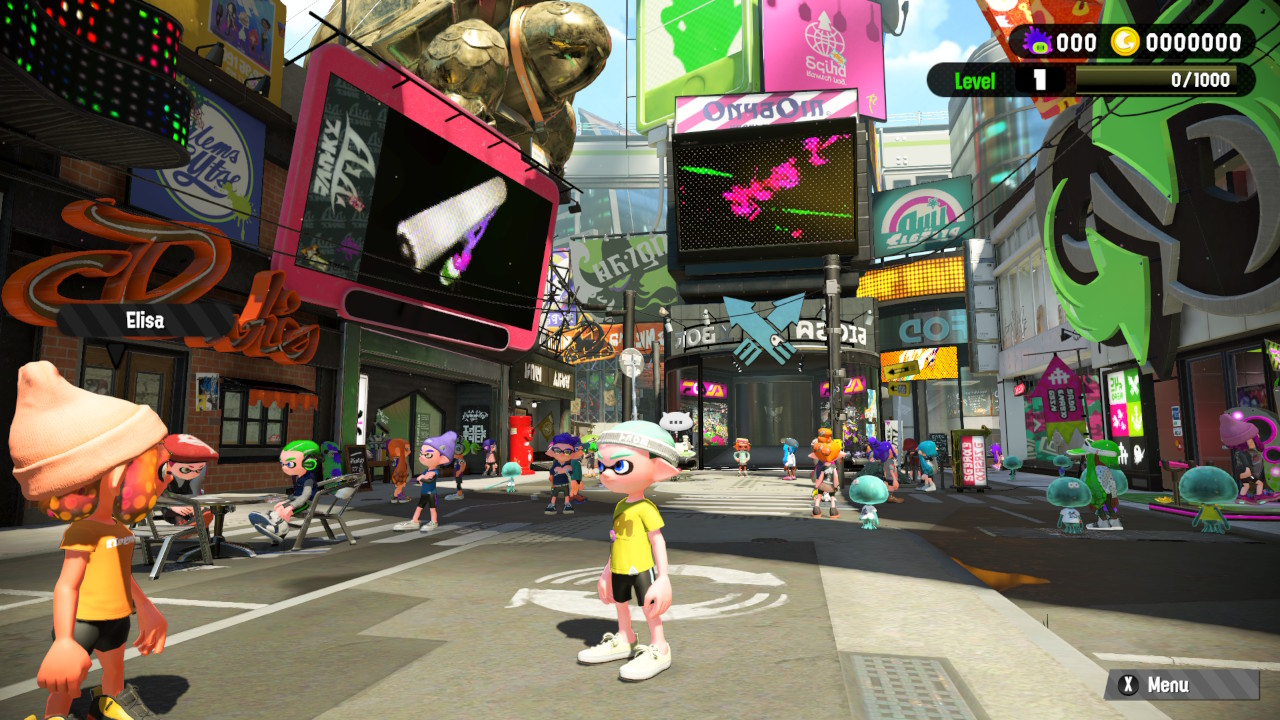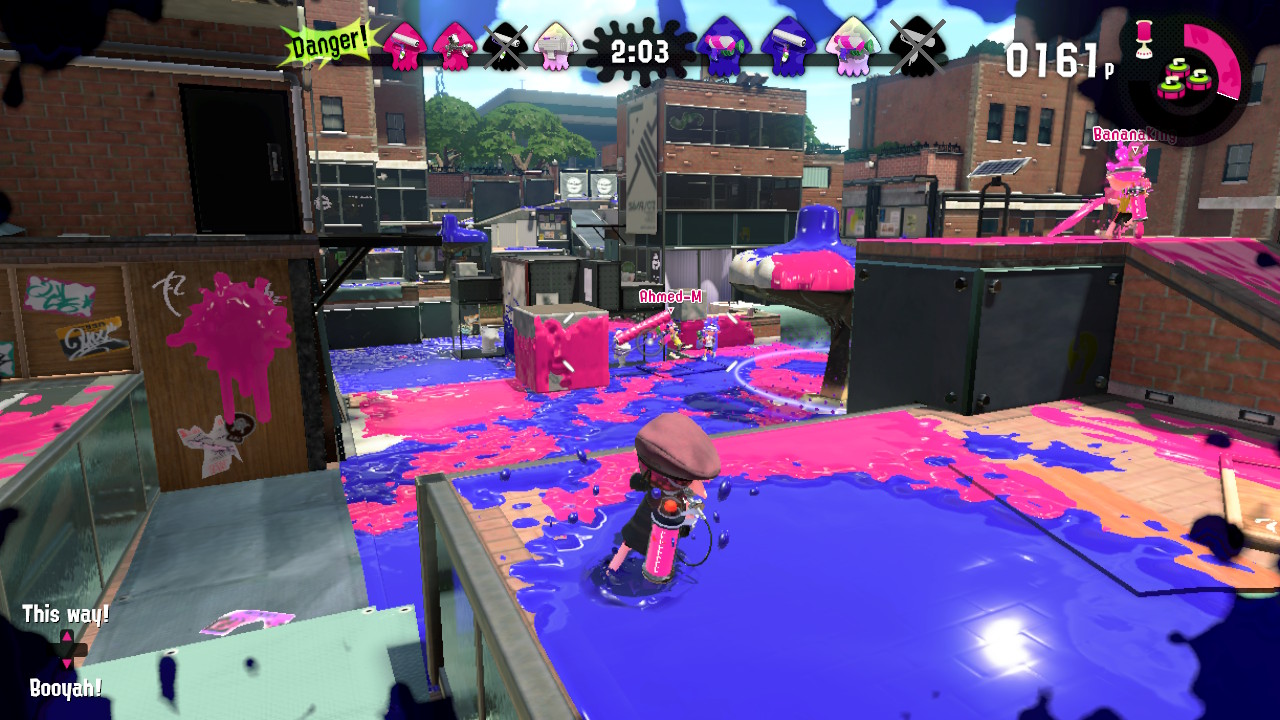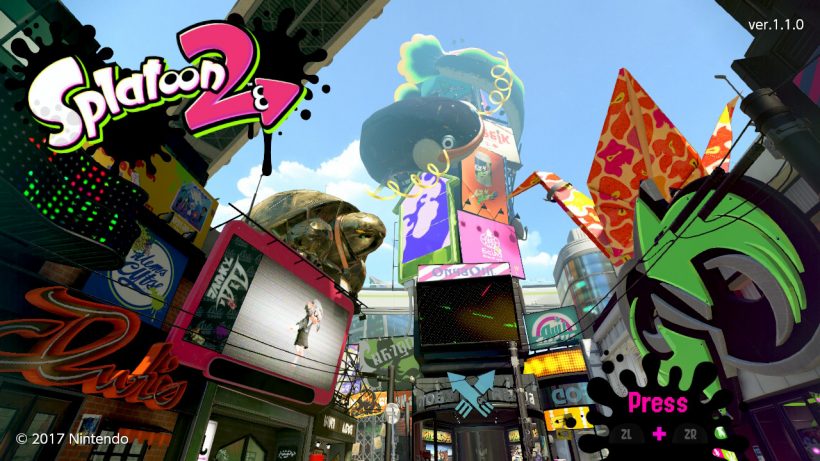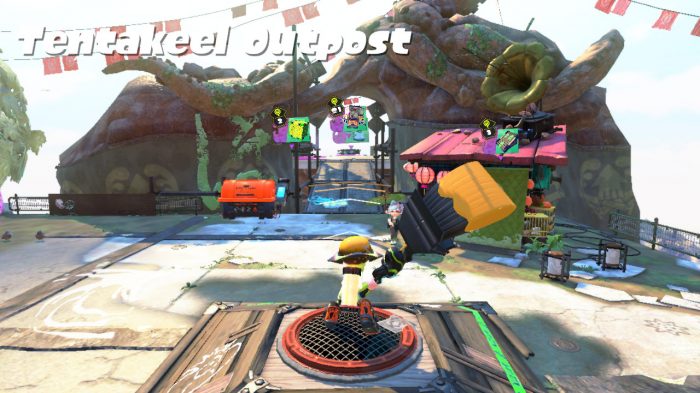I’ll have some calamari instead of cod, please.
Splatoon 2 is a colourful team-based multiplayer-focused third-person shooter from Nintendo. That would have been an absurd statement to have written a few years back, but every so often Nintendo like to dabble with new things (read: innovate) and come up with something extraordinary in the process.
The first Splatoon was a stellar hit when it launched on the Wii U (especially in Japan), so it’s no surprise to see a sequel, and even less surprising to see it on their newest system. The question then comes down to whether there’s enough here to justify being a numbered sequel, followed closely by whether it has that same spark that made the first game such a hit. The answer to both of those queries is a resounding yes, thankfully.
At it’s core, Splatoon 2 is very much focused on the multiplayer element of the game – and I’ll get to that shortly, but as there are three distinct parts to the game I’d like to start off with the single player campaign; Hero Mode. This mode is where you’ll hone your skills, learn to use the variety of weapons at your disposal, and generally have a great (if occasionally frustrating) time.

In the world of Splatoon you play as Inklings – humanoid beings with the ability to transfigure into a squid – and this title sees your adventure begin on the day that you move into Inktropolis. All is not well however, as once again the Great Zapfish that powers the city has been fish-napped – and to complicate things further, one of the superstar Squid Sisters (Callie) is also missing. As luck would have it, it seems that you are everything that is needed to save the day, so after a brief exchange with the other half of the Squid Sisters (Marie – you get the joke, right?) you are soon thrust into the depths of Octo Canyon. It’s here – below the surface – that your adventure begins.
You’ll then find yourself in the first of five hub worlds, a place dubbed Tentakeel Outpost, and the first three missions in front of you. As noted, the aim of the game is to rescue all of the missing Zapfish, defeat the evil Octarian forces, and find out what happened to Callie. To do so will require you to best over two dozen missions and five bosses, so you’ll need to slide your way over to the first “Mission Kettle” – the device which acts as the entry point for all missions.
Hero Mode serves as a (mostly) enjoyable romp within which you can acclimatise yourself to the controls. Whether you are a returning Splatoon player, or new to the series – like I am, and I’m sure many will be – there are plenty of things you will need to get used to. Presented in the third-person, the left analogue stick controls your Inkling’s movement, and the right moves your camera viewpoint – although by default the Nintendo Switch’s gyroscopic controls are in play, both with any form of the Joy-Con or Pro Controller. It’ll come down to personal preference, but it’s something I found to be off-putting.
The ZR button will use your weapon – which can vary wildly from blasters, to rollers, to paint brushes, or more obscure tools like buckets or even an umbrella! Depending on what you have equipped, that trigger will ensure a steady spread of paint wherever you are looking. This ink supply is not unlimited however, and can be replenished by holding down the ZL button in a pool of your native ink supply. Whilst in this squid guise you can also swim faster, jump much further with B than you would in your humanoid form, and play more defensively (read: duck) whilst tackling the tricky foes your encounter. In this mode you’ll also come across special moves, which are executed by clicking the right stick down and following the on-screen prompt – often resulting in devastating consequences for your enemies.

Each level has a very linear path from start to finish and there’s practically no room for exploration, but this doesn’t mean that the gameplay is boring – far from it. You’ll traverse from short section to short section via portals, defeating enemies, avoiding obstacles, climbing walls, making jumps, gliding rails, and finding keys. Although exploration is to a minimum, there are two hidden collectibles in each mission, scrolls which reveal some of the Splatoon lore, and Sardinium which is needed to upgrade your kit.
Each time you move on via a checkpoint you’ll top up your lives to a maximum of three (the default), giving you plenty of opportunities to complete each level – which can vary from as short as five minutes to around twenty. Each one is completed by rescuing the zapfish contained therein, upon which you are returned to the central hub.
All of the missions in each world are numbered, but you do not have to proceed in order. That said, all must be completed before you can face off against the boss of that world – which can be accessed via the Boss Kettle. Bosses themselves are particular highlights, and although they require only a few hits to take out, you’ll need to avoid their offensive tactics before climbing onto them and bashing their exposed tentacle. All five boss fights are incredibly fun, and varied enough from each other to stand apart as unique experiences.
The good news is that everything – including these boss fights – can be replayed to obtain more orbs (the games’ currency for upgrading equipment) or reduce your times. You can also play with different weapons as you unlock them, which is handy since many are locked to a specific weapon when you first play them. This can be quite frustrating late-game by the way, as it happens quite frequently…

The presentation in Splatoon 2 is to a very high standard. Every time you start the game you are “treated” to a television style introduction showing you what’s new, with the current online modes and maps (more on that later) laid out by Pearl and Marina – who then helpfully advise you how to avoid being eaten. Everything is incredibly vibrant and colourful, done in a rather beautiful art style. It feels incredibly polished, and the game has a very catchy (if slightly repetitive) soundtrack.
Whilst Hero Mode is an incredibly welcome side-show for Splatoon 2, it really is a side-show to the centrepiece; multiplayer. In that vein, there’s quite a lot to play through. The first thing you need to get your head around with Splatoon 2 is that whilst it’s described as a shooter, simply killing your cephalopod enemies isn’t going to cut the mustard. Whilst you can shoot your enemies and satisfyingly watch them explode into an inky mess, it’s not going to contribute too much to your main objective.
For instance, in Turf War – which will be the standard mode for many – two teams of four will face off for three minutes of battle where the aim is to cover the arena in more of your luminous ooze than your opponents do. Working together with your team you’ll need to take all of your skills and expertise with the weaponry at hand to chuck your goo all over the show – and you’ll be ducking, diving, gliding, and dying as you do. Of course, the opposing team aren’t just going to let you spray your stuff everywhere, which results in three minutes of hectic chaos!

As well as the standard controls at your disposal, there’s another action that I’ve not yet mentioned; the Super Jump. On the Wii U the gamepad acted as your map, allowing you to instantly launch to a team mates location. The absence of a second screen here for Splatoon 2 removes this fluidity somewhat, but by opening the map with X you can choose an active player’s location and land with them by confirming with A.
Just like in Hero Mode, multiplayer gives you access to a sub-weapon (dependent on your ink level), and a special weapon – both tied to your primary weapon. Your special is charged by your score, so the more ink you spray the quicker your special move can be unleashed!
At the end of each match you’ll earn experience points and cash, and after a few matches you’ll level up. Outside of battles you’ll be able to frequent the many shops available within Inktropolis, and if you have the cash you can even buy some new clobber. This gear here isn’t just cosmetic though, as everything you can buy will have special abilities and perks attached – some unlocking further as you level up. That said, you’ll also get access to higher level gear as you progress… so you’ll have to balance upgraded perks with the latest and greatest possibilities.

Want to allow your ink to fill up quicker, or move faster through the ink? Allow your special to recharge quicker, or hinder your enemy when they re-spawn? There’s many different clothing options available to suit your play style. The same goes for the weapons, and – as you might expect – new weapons become available as you progress through the levels. While you’ll initially start off with the baby blaster, before long you’ll have many variations of the standard gear available – some with better sub weapons, specials, and stats to assist you. The level of customisation available here is superb, and there’s no doubt that you will ultimately stumble on a combination that suits you if you play around.
Another shop of sorts available to you is a food vendor featuring Crusty Sean, which will allow you to exchange vouchers that you earn from other modes for select food and drink items. These edible items will enhance your abilities temporarily, so use them if you need them! Want more cash? More experience points? Or some specific perks? All you have to do is head over to the little van parked at the back of Inktropolis – much as you would when looking for a kebab after a night on the lash – to gain your little boost.

After a little while of playing Turf War, you’ll earn enough experience to reach level 10. This is where ranked battles become available, with even more competitive modes coming into play. From here you can play Rainmaker; a “capture the flag” style mode where you have to take the eponymous item to the opposition pedestal within the time limit – all the while attempting to stop the other team from doing the same. Knowing your way around the maps will be essential, as will working as a team. The player carrying the Rain Maker will be unable to attack with their default weapon set, so protecting your teammate will be crucial. You can charge and unleash the Rainmaker yourself – resulting in typically explosive consequences, but the reality is that it’s quite time consuming and risky. If there is no winner during the regulation time, the winner will be the team that got it the closest. It’s frantic, it’s fun, and it’s ever so addictive.
Also in ranked is Tower Control, which – in case you weren’t sure what will be required from the name – means you’ll be attempting to control a tower. It’s a bit similar to Rainmaker in that you and your team need to carry an item to the opposition target, the big difference in this case is that you need to commandeer and push a tower! The more of you aboard, the more effective you will be. Just remember that it will stop every so often at checkpoints and as you’d expect, reaching your target destination (or getting the closest when the time runs out) will ensure your victory.
Finally, Splat Zones is your “king of the hill” style mode where you’re required to control specific zones for a period of time. Set points within the map need to be inked and “controlled,” and the game runs until a team reaches 100 or the time runs out. With such a small portion of the map in play it can become quite frenetic, and with such a scramble for limited section the tide of battle can swing in an instant!
There’s quite a lot of variety in the eight different multiplayer maps, and all feel distinctly different to each other. With the exception of Turf War (which is always on), all other multiplayer modes cycle in two hour intervals – constantly changing up the maps and modes on offer.

By now you’d almost think you were a pro with your minimum level 10 rating and your B- rating for ranked, but that’s where League Battles kick in. Unfortunately, this writer wasn’t able to spend enough time with Ranked Battles to rank up enough to get into them – but they’re there, for those that want even more challenging carnage!
If all of that isn’t enough for you, then Splatoon 2 has one more mode available to you (and what a trump card it is). This mode is called Salmon Run, and it’s limited to selected times. When it’s available simply head over to Grizzco (next to the tower) and you’ll be tasked with being in the employ of Mr. Grizz. A man who fancies himself as the next John West, he wants you to collect some golden Salmonid eggs for him. This is achieved by facing off against a variety of fishy monsters over three waves, with a certain amount of eggs required per wave. You will be assigned a random weapon during each bout, so proficiency with various tools will be essential as will coordination and planning with your team mates. Successfully surviving all three waves will end the run, earn you bonus points, and see you get promoted.
The catch however, is that as your rank increases so does the difficulty of the waves. As you can imagine, this will become rather brutal very quickly. Not only do you have to face off against seven different boss Salmonids, a plethora of small-fry creatures, chum, and other difficult challenges, but the weather can shift as well as the tide. You’ll need to be prepared to die (and die often), but thankfully it’s never permanent. As with other games that feature a wave-based or horde-style mode, if you are defeated you’ll end up in a done-but-not-out situation where you are afloat via a rubber ring. You can still move around the splattlefield and even retrieve the golden eggs, but cannot attack. You’ll be revived when shot by a teammate’s ink, but it’s permanent if you are all down (so you’ll probably want to avoid that).

Salmon Run is without a shadow of a doubt one of the best parts of Splatoon 2, but having only three waves (although understandable at higher difficulty levels) and just two maps initially is a little bit of a let-down. More than that, the restriction is incredibly frustrating. I can understand wanting to keep it populated, but it’s going to be annoying for those that want to play online with others on their (possibly tight) schedule.
I’ve been mostly impressed with Splatoon 2. It’s an incredible game with an interesting spin on an established genre, but there are a few things that aren’t great. Being forced to use some weapons in Hero Mode is annoying, and aside from earning tickets for Crusty Sean and multiplayer benefits you won’t head back to the single player too much once you’ve beaten it. That’s fine, because there’s so much variety and lasting appeal, not to mention fun to be had with the multiplayer aspects. As mentioned, Salmon Run is so much fun – but it’s frustrating that it’s time-limited. I guess it is so that it doesn’t detract from the other modes too much, and so that they can maximise the amount of people playing at once, but for those playing locally with others it won’t be that much of an issue. The online limitations are also present with other modes too, with a choice of two maps and one ranked mode cycling every few hours or so. It’s certainly an odd way of managing the online, which is something that can be said about my next point as well.
My biggest gripe with Splatoon 2 is the Nintendo Switch’s lack of a native voice chat option. Sure, the online app is launching with the game, but it looks so much like hard work for what simply should be on the Switch and in the game natively. Nintendo have allowed voice-chat on other online titles previously, and it’s simply a shame that they are so restrictive about it when there are already so many safe measures in place. It’s a handicap, though I guess it’s equally likely that those with regular online friends will simply use Discord, Skype, or something else instead. It’s a major grievance for me, as I’m sure it will be for many of those playing, but between that and the online availability/rotations it really is about the worst thing I can highlight.

However, in the bigger picture, these are not game-breaking issues, more problems of convenience. Across the board this is yet another accomplished package and one that’s sure to fly off the shelves, as the original did. When you take a successful formula and improve on it in so many ways, you cannot see anything other than yet another hit.
There is so much here to enjoy and with the promise of additional content and support and regular events to play online, this is something that you are going to be playing for some time. I’ve been playing my Switch non-stop since March, but I’ve probably played this more in the last week than I’ve played anything else.
I have not been able to put it down, except to recharge the Switch’s battery. It’s so simple, but so effective, and simply dripping with that Nintendo charm. Essential for all Switch owners, shooter fans and people that just love to have fun. It’s got your multiplayer needs covered.
Splatoon 2
-
Presentation
-
Gameplay
-
Lasting Appeal
-
Execution
-
Usability
Summary
If you had to describe Splatoon 2 in a single word, it would simply be “fun”. Pure, unadulterated fun that will last you a significant amount of time. With competent single player mode, addictive multilayer modes and the promise of regular content it’s another top quality – and essential – Switch release. Just make the Salmon Run more frequent, Nintendo.




Great review and more believable score.